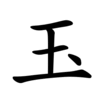玉
| ||||||||
| ||||||||
Translingual
| Stroke order | |||
|---|---|---|---|
| Stroke order (Chinese) | |||
|---|---|---|---|
 | |||
| Stroke order (Japan) | |||
|---|---|---|---|
 | |||
Alternative forms
- 𤣩 (When used as a radical component)
Han character
玉 (Kangxi radical 96, 玉+0, 5 strokes, cangjie input 一土戈 (MGI), four-corner 10103, composition ⿱一圡 or ⿷王丶)
- Kangxi radical #96, ⽟.
- Shuowen Jiezi radical №6
Derived characters
References
- KangXi: page 726, character 4
- Dai Kanwa Jiten: character 20821
- Dae Jaweon: page 1135, character 6
- Hanyu Da Zidian (first edition): volume 2, page 1100, character 1
- Unihan data for U+7389
Chinese
| simp. and trad. |
玉 | |
|---|---|---|
| alternative forms | 王 𤣩 𠀛 | |
Glyph origin
| Historical forms of the character 玉 | |||||||||||
|---|---|---|---|---|---|---|---|---|---|---|---|
| Shang | Western Zhou | Spring and Autumn | Warring States | Shuowen Jiezi (compiled in Han) | Liushutong (compiled in Ming) | Libian (compiled in Qing) | Kangxi Dictionary (compiled in Qing) | ||||
| Bronze inscriptions | Oracle bone script | Bronze inscriptions | Bronze inscriptions | Bronze inscriptions | Chu slip and silk script | Qin slip script | Ancient script | Small seal script | Transcribed ancient scripts | Clerical script | Ming typeface |
 |
 |
 |
 |
 |
 |
 |
 |
 |
 |
 |
 |
Characters in the same phonetic series (玉) (Zhengzhang, 2003)
The character's shape was historically very similar to 王; a dot was introduced to differentiate the two.
Pictogram (象形) : a picture of a cong (琮), a sort of ritual jade totem.
It is also interpreted as three pieces of jade strung together on a string.
Etymology
STEDT compares it to Proto-Sino-Tibetan *r-lu(ŋ/k) (“stone”), which is also compared to 琭 (OC *roːɡ).
Pronunciation
Definitions
玉
Synonyms
- (jade): (Taiwanese Hokkien) 玉仔
Compounds
Derived terms from 玉
|
|
|
Descendants
Others:
References
- “玉”, in 漢語多功能字庫 (Multi-function Chinese Character Database), 香港中文大學 (the Chinese University of Hong Kong), 2014–
- Dictionary of Chinese Character Variants (教育部異體字字典), A02553
Etymology 2
| For pronunciation and definitions of 玉 – see 鬱 (“lush; luxuriant; exuberant; dense; thick; various; abundant; profuse; etc.”). (This character, 玉, is the draft (1955) first-round simplified form of 鬱.) |
Notes:
|
Japanese
Kanji
玉
- gem, jewel
- beauty, elegance
- euphemistic term related to an Emperor of Japan
- euphemistic term related to a partner
- geisha
Readings
Counter
玉 • (-tama)
See also
Noun
玉 • (tama)
Derived terms
Descendants
- → Korean: 다마 (dama)
Prefix
玉 • (tama-)
- This term needs a translation to English. Please help out and add a translation, then remove the text
{{rfdef}}.
Derived terms
Derived terms
- 玉垣 (tamagaki)
- 玉櫛笥, 玉匣 (tamakushige)
- 玉砂利 (tamajari)
- 玉襷 (tamadasuki)
- 玉藻 (tamamo)
Pronunciation
Noun
玉 • (gyoku)
- a gem, jewel
- generic name for jadeite or nephrite
- chicken eggs used as food, especially as a topping for sushi
- Synonym: 鶏卵 (keiran)
- a stock being traded
- Short for 建て玉 (tategyoku): This term needs a translation to English. Please help out and add a translation, then remove the text
{{rfdef}}. - a geisha
- Synonym: 芸者 (geisha)
- Short for 玉代 (gyokudai): This term needs a translation to English. Please help out and add a translation, then remove the text
{{rfdef}}.
Idioms
- 玉を吞む (gyoku o nomu)
Etymology 3
| Kanji in this term |
|---|
| 玉 |
| ぎょく Grade: 1 |
| on’yomi |
Derived terms
- 入玉 (nyūgyoku)
Korean
Vietnamese
Derived terms
- 玉 (Ngọc)
- 玉佩 (ngọc bội)
- 玉兔 (ngọc thỏ, “moon, Jade Rabbit”)
- 玉堂 (ngọc đường, “imperial palace”)
- 玉女 (ngọc nữ, “beautiful girl”)
- 玉照 (ngọc chiếu)
- 玉版 (ngọc bản)
- 玉皇 (ngọc hoàng, “Jade Emperor”)
- 玉石 (ngọc thạch, “jade”)
- 玉莖 (ngọc hành)
- 玉蘭 (ngọc lan, “magnolia”)
- 玉趾 (ngọc chỉ)
- 玉體 (ngọc thể)
- 璧玉 (bích ngọc)
- 白玉 (bạch ngọc, “pearl, white jade”)
- 紅玉 (hồng ngọc, “ruby”)
- 金玉 (kim ngọc)
This article is issued from Wiktionary. The text is licensed under Creative Commons - Attribution - Sharealike. Additional terms may apply for the media files.